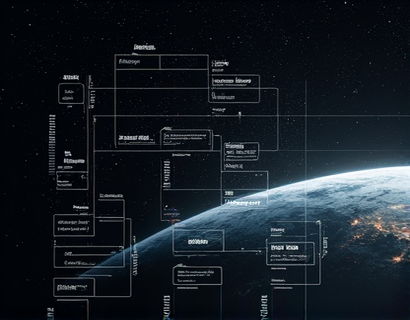Unlocking Market Success in Modern Ecosystems: Navigating Economic Dynamics and Opportunities
In the rapidly evolving landscape of modern economies, understanding and navigating the complex dynamics of ecosystems has become crucial for professionals across various fields. This comprehensive guide aims to provide strategic insights and detailed analysis to help economists, business leaders, investors, and industry experts identify and capitalize on emerging market opportunities. By exploring the economic dynamics and leveraging the unique opportunities within these ecosystems, stakeholders can stay competitive and informed.
The concept of an ecosystem in an economic context refers to a network of interconnected entities including businesses, consumers, suppliers, and regulators, all interacting within a specific market or industry. These ecosystems are dynamic, constantly adapting to technological advancements, regulatory changes, and shifts in consumer behavior. To unlock the economic potential of these ecosystems, it is essential to grasp the underlying principles and mechanisms that drive their growth and evolution.
Understanding Economic Ecosystems
An economic ecosystem is characterized by its complexity and interdependence. Each entity within the ecosystem plays a vital role, contributing to the overall health and resilience of the system. For instance, in the technology sector, companies like Apple, Google, and Amazon are not just competitors but also collaborators, influencing each other's strategies and innovations. This interplay creates a rich environment for innovation and growth.
To effectively navigate these ecosystems, professionals must first understand the key components. These include:
- Actors: The entities participating in the ecosystem, such as firms, consumers, and regulators.
- Resources: The assets available within the ecosystem, including financial capital, human capital, and intellectual property.
- Relationships: The interactions and dependencies between actors, which can be cooperative or competitive.
- Institutions: The rules, norms, and organizations that govern behavior within the ecosystem.
By mapping these components, stakeholders can identify leverage points and potential areas for intervention. For example, a business might focus on strengthening relationships with key partners or investing in research and development to stay ahead of the curve.
Economic Dynamics Within Ecosystems
The economic dynamics within ecosystems are driven by various forces, including technological innovation, market competition, and policy changes. Understanding these dynamics is crucial for predicting trends and making informed decisions.
Technological Innovation: Technological advancements are a primary driver of change in economic ecosystems. Innovations can disrupt existing markets, create new ones, and alter the competitive landscape. For instance, the rise of e-commerce has transformed traditional retail, forcing brick-and-mortar stores to adapt or risk obsolescence. Companies that embrace and leverage new technologies are more likely to thrive in these dynamic environments.
Market Competition: Competition within ecosystems can take many forms, from price wars to innovation battles. The level of competition influences pricing strategies, product development, and market entry barriers. In highly competitive ecosystems, firms must continuously innovate and differentiate themselves to maintain a competitive edge. Strategic alliances and partnerships can also be effective ways to mitigate competition and share risks.
Policy Changes: Government policies and regulations play a significant role in shaping economic ecosystems. Changes in tax laws, trade policies, and environmental regulations can have far-reaching impacts on businesses and consumers. For example, the implementation of stricter environmental regulations has prompted many industries to adopt sustainable practices, opening new markets and creating demand for eco-friendly products.
Identifying Emerging Opportunities
To capitalize on emerging market opportunities, it is essential to stay ahead of trends and anticipate future shifts. This involves a combination of market research, scenario planning, and strategic foresight.
Market Research: Conducting thorough market research is the foundation of identifying new opportunities. This includes analyzing consumer behavior, market size, growth potential, and competitive landscape. Tools such as SWOT analysis (Strengths, Weaknesses, Opportunities, Threats) and PESTEL analysis (Political, Economic, Social, Technological, Environmental, Legal) can provide valuable insights.
Scenario Planning: Scenario planning involves creating multiple possible future scenarios to prepare for different outcomes. By considering various "what if" scenarios, businesses can develop flexible strategies that are resilient to change. For example, a tech company might consider scenarios where 5G technology becomes widely adopted, leading to new applications and services.
Strategic Foresight: Strategic foresight involves looking beyond current trends to anticipate long-term shifts. This requires a deep understanding of underlying drivers such as demographic changes, technological advancements, and societal values. By aligning strategies with these long-term trends, businesses can position themselves for sustained success.
Strategies for Capitalizing on Opportunities
Once opportunities are identified, the next step is to develop effective strategies to capitalize on them. This involves a combination of innovation, collaboration, and agility.
Innovation: Innovation is key to staying competitive in dynamic ecosystems. This can take many forms, from product innovation to business model innovation. Companies that continuously push the boundaries of what is possible are more likely to capture new market share. For example, a healthcare firm might develop a new diagnostic tool that integrates AI to improve accuracy and efficiency.
Collaboration: In many cases, the best way to capitalize on opportunities is through collaboration. Partnerships with other firms, research institutions, or even competitors can lead to shared resources, reduced risks, and accelerated innovation. Open innovation platforms and consortia are becoming increasingly common, fostering collaboration across traditional industry boundaries.
Agility: The ability to adapt quickly to changing conditions is crucial in dynamic ecosystems. This requires a flexible organizational structure, a culture of experimentation, and a focus on rapid prototyping and iteration. Companies that can pivot swiftly in response to new information or market signals are better positioned to seize opportunities as they arise.
Case Studies: Successful Navigation of Economic Ecosystems
Examining real-world examples can provide valuable insights into how businesses have successfully navigated economic ecosystems.
Apple Inc.: Apple's success can be attributed to its ability to innovate and create new markets. The introduction of the iPhone not only disrupted the mobile phone industry but also created a new ecosystem of apps, services, and accessories. Apple's focus on design, user experience, and brand loyalty has allowed it to maintain a strong market position despite intense competition.
Tesla, Inc.: Tesla has transformed the automotive industry by pioneering electric vehicles and autonomous driving technology. By building a comprehensive ecosystem that includes manufacturing, software development, and energy solutions, Tesla has disrupted traditional automakers and established itself as a leader in the transition to sustainable transportation.
Amazon.com, Inc.: Amazon's journey from an online bookstore to a global e-commerce giant is a testament to its strategic foresight and adaptability. By continuously innovating in areas such as logistics, artificial intelligence, and cloud computing, Amazon has expanded into new markets and created new demand. Its ability to leverage data and customer insights has been crucial in maintaining its competitive edge.
Conclusion
Unlocking the economic potential of modern ecosystems requires a deep understanding of their complex dynamics and a proactive approach to identifying and capitalizing on emerging opportunities. By mapping the key components of ecosystems, staying informed about economic dynamics, and implementing effective strategies, professionals can navigate these environments with confidence and success. Whether you are an economist, business leader, or industry expert, embracing the principles of ecosystem thinking is essential for staying competitive and informed in today's rapidly changing economic landscape.










































